Acrylic Flashing Tape Keeps It Together
Making tighter building envelopes possible
![]() Continuing Education
Continuing Education
Use the following learning objectives to focus your study while reading this month’s Continuing Education article.
Learning Objectives - After reading this article, you will be able to:
- Name various types of flashing as they relate to building soundness.
- Identify and compare three types of construction tapes that are commonly used for flashing around windows, doors, and penetrations.
- Discuss the importance of an air barrier system in building integrity.
- Identify testing standards for self-adhered flashing tapes as they promote safety of buildings and occupants.
Builders have long battled the intrusion of unwanted moisture and air into their structures. Water of any kind is a prime factor in building damage, and can cause mold growth, decay, and corrosion responsible for both health and structural durability issues—that goes for both gross water leakage into the structure as well as for infiltrated air through the building envelope which can result in the condensation of moisture. Every year billions of dollars are spent combating moisture intrusion and rectifying its harmful effects. When it comes to preventing moisture or bulk water into a building, flashing is on the front lines. Placed around windows, doors, and other penetrations, flashing protects the building envelope and is a prime defense against unwanted moisture penetration and its consequences.
How well flashing accomplishes its intended mission depends on the material used and its proper placement and installation. This article will offer a comparative discussion of various types of flashings, with an emphasis on the incorporation of acrylic tapes. Tests and standards for determining durable, reliable, self-adhered flashing materials will also be discussed, as well as the role these materials play in creating effective air barrier systems.
Flashing—The Basics
A thin continuous piece of impervious material applied to prevent the passage of water into a structure from an angle or joint, flashing is a key protector against leaks and water damage. Flashing, which may be either exposed or concealed, has to be carefully applied so that water is actually directed away from the structure and not inside. Sometimes flashing is improperly installed by inexperienced laborers who do not understand its purpose, which can result in severe water intrusion and mold. The service life of flashing can determine the service life of an entire building. There are several types of flashing available.
Rigid Flashings/Sheet Metal
Plastic sheets or sheet metal, generally aluminum, copper, painted galvanized steel, stainless steel, lead or lead-coated copper, can also be used as flashing materials. Sheet metal can be molded to fit a space, though expansion joints should be provided to prevent deformation of the metal. The selected metal should not stain or be stained by adjacent materials or react chemically with them. Plastics may cost less than other materials, and can be tough, flexible, and durable. Many plastic products are made of polyvinyl chlorides, which may deteriorate considerably when exposed to ultraviolet light, and consequently should be concealed.
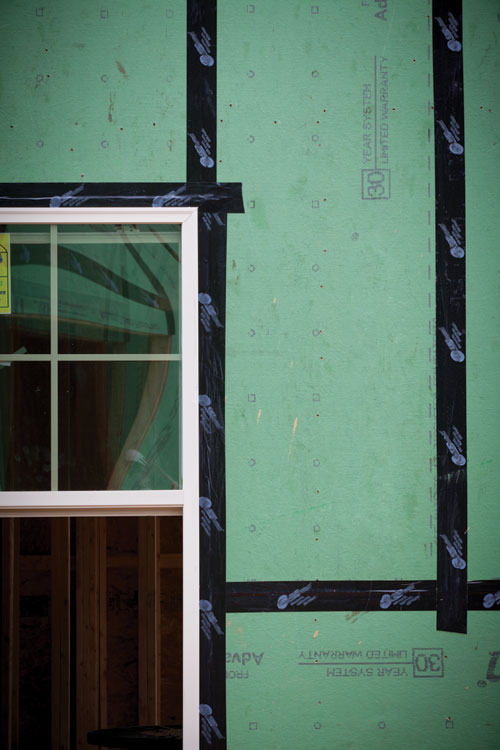 |
Acrylic flashing tape enables an airtight building. Photo courtesy of Huber Engineered Woods |
Self-Adhered Flashing
Today, many builders use pressure-sensitive membranes to flash around windows, doors, and other penetrations. These self-adhered materials will stick to a surface with applied pressure without the need for any type of solvent, heat, or water for activation. Generally these membranes consist of pressure-sensitive adhesives that are coated onto paper, plastic, cloth, foil, or other backing material. In some self-adhered flashing, a removable liner acts to protect the adhesive. These so-called peel and stick membranes are typically 4 to 12 inches wide and facilitate creation of a continuous barrier around windows and doors in wood frame construction. Some tapes used for flashing purposes can also be used to properly seal the seams in sheathing to prevent water entry through these and other penetrations. Pressure-sensitive tapes are bendable, and consequently able to achieve a more accurate fit around windows, doors, and penetrations. If pressed firmly into place, most pressure-sensitive tapes bond well to a range of materials from wood-based products to metal, and accommodate movement from expansion and contraction. Correctly installed flashing tapes can provide long-lasting waterproof protection.
Generally speaking, self-adhered tapes offer several benefits over other types of membrane flashing. Installation is faster, with no cure time or clamping required, or the need for special tools to brush on adhesive material. Greater efficiencies translate to a more cost-effective process, with less time and resources expended in setup, installation, and clean up, and fewer products such as tubes and buckets to dispose of. Tapes also help to raise a building's green quotient. The absence of volatile organic compounds (VOCs) means less exposure to toxic fumes, along with minimization or outright avoidance of toxic landfill contributions from residual liquid adhesive waste. Clean up necessitating hazardous solvents is eliminated as is toxic outgassing during cure time.
The Evolution of Construction Tapes
Building materials are constantly evolving, with manufacturers offering new and improved products that contribute to a building's energy performance and service life. Construction tapes are no exception, and relatively recent advances have shown superior durability and performance under a range of temperature and climate conditions.
Asphalt Tapes
It used to be that most construction tapes were asphalt-based tapes. Asphalt tapes are made from modified bitumen, similar to the rubberized asphalt commonly found in eaves flashing. Though widely used, asphalt tapes have several drawbacks. They are messy to install, and their durability is often of questionable quality. A priming may be required to achieve a full bond with some substrate materials, such as oriented strand board (OSB) and concrete, which may present particular problems for certain asphalt flashings.
Asphalt tapes also have a poor temperature range. According to the Encyclopedia of Building & Environmental Inspection, Testing, Diagnosis, Repair, many rubberized asphalt products start to lose stickiness at around 50°F and have problems bonding below 40°F. Unless the rubberized-asphalt product is specifically formulated for low temperatures, other products are a better choice in colder weather situations. Problematic application also applies when asphalt tape is subjected to high temperature or direct and prolonged sunlight. The asphalt will soften and begin to flow between 185°F and 210°F. Some asphalt membranes are specially formulated for high-temperature situations and can withstand temperatures of up to 240°F, though they are typically not as sticky.
Butyl Tapes
Butyl rubber is a synthetic rubber, or elastomer, a copolymer of isobutylene with isoprene. It is impermeable to air and used in many applications requiring an airtight rubber. Butyl tape has a butyl rubber core, and has an expanded temperature range and greater durability than its asphalt counterpart, that is, it stays more flexible in cold weather and is more stable at high temperatures than asphalt tapes. Compared to asphalt tapes, butyl products form better bonds with difficult substrates and can be peeled off and adjusted during installation. However, butyl-based tapes are often susceptible to UV degradation, drying, and degradation of its adhesive properties. The temperature range is greater than asphalt, with application from 40 to 120°F, and service from -40 to 200°F. Typical recommendations are to avoid installation below 40°F unless it can be verified that the surface is free of moisture and contaminants. There are some tapes that can be installed in lower temperatures with the use of a primer.
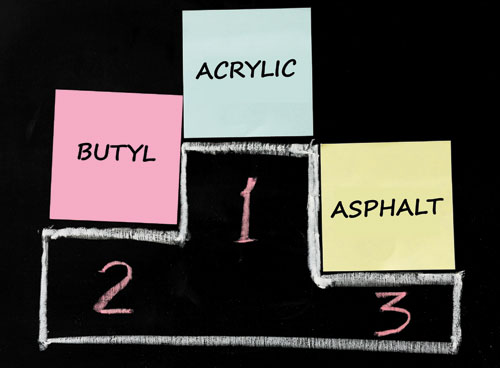 |
|
Illustration courtesy of Huber Engineered Woods |
Acrylic Tapes
Acrylic tapes are engineered for superior durability and temperature range and have been shown to perform so well that they are routinely used not only in the construction field but in high-performance applications in the automotive, marine, and aviation industries as well.
Water-based, solvent-based, or “solid,” acrylic tapes are becoming increasingly popular. The least expensive acrylic tape is water-based; however, this type of tape may not bond to as many types of substrates as the other varieties. According to BuildingGreen.com, “solid acrylic adhesives can form the strongest adhesive bonds at a wide range of temperatures and even achieve adhesion to damp or wet substrates.” Without solvents, the tapes do not become brittle over time.
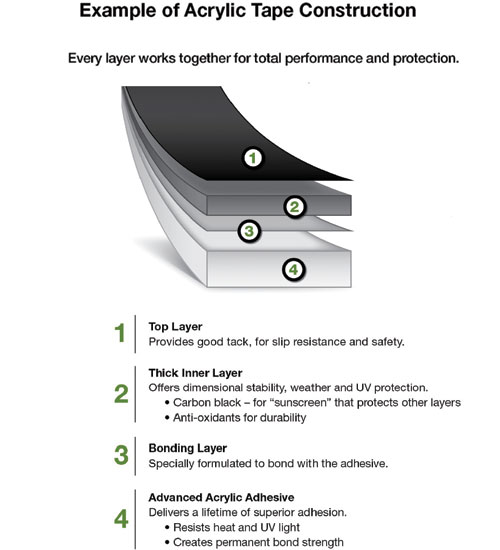 |
Illustration courtesy of Huber Engineered Woods |
Advanced acrylic adhesive is made of highly polar molecules, meaning a magnetic-like attraction pulls the adhesive into the substrate. Some acrylic tapes are formulated to flow into every crevice, increasing total contact area. This helps the tape wet out well, flowing into surface inconsistencies to produce a permanent bond. The result is a superior, lasting seal that is considerably stronger than traditional asphalt and butyl tapes. With both robust adhesion and cohesion, advanced acrylic tapes are internally strong—intertwined polymer chains provide excellent internal strength, adding to the overall reliability of the seal.
Using acrylic tape to seal high-performance wall panels is gaining popularity in the building industry. Builder Paul Fournier of Lewiston, Maine, is enthusiastic about the convenience afforded by that scenario. “We built the walls on the floor, taped them, installed windows, and raised them and were ready for siding. No having to deal with housewrap that would blow away,” Fournier says. “Same with the roof, we installed it, taped it, and were ready to roof it without having to worry about underlayment.” Builder Miguel Hewett of Southport, North Carolina, had a similar experience. “The high-performance roof saved me so much time because you just put in the panels and tape and you're done. There's no felt or rework. It hardly took any time for my crew to learn how to use the tape, and it just gets easier every time they use it.”
Acrylic Tape—Why It Works
Acrylic tapes perform well as a result of several contributing factors.
Viscoelasticity
This term refers to having viscous as well as elastic properties when deformed. Viscous behavior of a material can be imagined as the way in which honey responds to stress from gravity. When honey is poured from a vessel, it moves slowly. That is because internal stresses between molecules increase with relative velocity between molecules. The faster the molecules move, the greater is the resistance to that movement. The less viscous the fluid is, like water, the greater its ease of movement. The reverse is true for thicker or more viscous materials. Elasticity is a property of materials that return to their original shape after deformation.
 |
Photo courtesy of Huber Engineered Woods |
 |
Photo courtesy of Huber Engineered Woods |
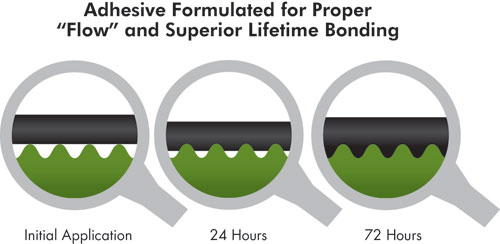 |
Illustration courtesy of Huber Engineered Woods |
Because acrylic adhesive is viscoelastic, it acts simultaneously as both a liquid (viscous) and solid (elastic). Its viscous properties allow it to flow into small surface cracks and abnormalities to form a strong bond. Its elastic nature means it possesses the adhesive strength necessary to preserve the bond. In other words, viscoelastic materials exhibit traits of both liquids and solids and enable superior initial adhesion, as well as the ability to dissipate stresses and resist compression, deformation, and flattening. Viscoelastic tapes are widely considered to be engineered for long-term jobsite performance.
Tape Construction
Each layer of acrylic tape is engineered for functionality. The illustration on the left is an example of how one type of advanced acrylic tape is constructed. The top layer provides tack for safety. A thick inner layer provides dimensional stability, weather and UV protection, with darker shades being the preferred color for sunscreen and containing sufficient antioxidants for durability. A thin bottom layer is formulated to bond with the adhesive layer.
Heat and UV Resistant
Heat and ultraviolet light are two key factors that degrade tape life. The acrylic adhesive in some tapes resists heat and UV sunlight far better than butyl and asphalt. Cross-linked polymer chains create extremely strong molecular bonds that withstand a much wider range of temperatures. In addition, they dissipate light energy, which can break the bonds in asphalt and butyl. Even in severe conditions, certain acrylic tapes retain superior adhesion strength for years. Rigorous durability tests have been developed to test tape against exposure to these factors. Accelerated aging tests simulate a “worst-case scenario” in terms of exposure to heat and UV over time. For example, some accelerated aging tests can be equivalent to 180 days initial exposure and then 30 years as a roof underlayment in Miami, Florida. Architects are well advised to consult the warranty terms for tape products. Some manufacturers are so confident in the long-term performance of their tape that they warrant it up to 30 years.
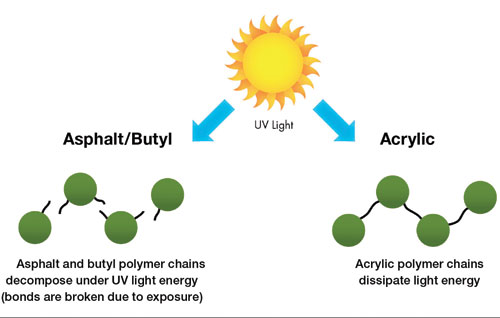 |
Illustration courtesy of Huber Engineered Woods |
Accommodation of Wall Characteristics
Some advanced acrylic tapes are designed to accommodate the normal expansion and contraction of walls. These acrylic tapes can adjust with a home over its lifetime, as some can flex and stretch up to 800 percent to accommodate the normal contraction and expansion of walls.
Testing—Standard and“Above and Beyond”
Architects should make sure that the tape they specify is code recognized as a flexible flashing tape and performs in accordance with the latest testing criteria and is recognized in an Evaluation Service Report. If so recognized, the tape has passed requirements of AC 148 (Acceptance Criteria for Flexible Flashing Materials). Architects should ensure that the tape intended for specification has passed these standards along with AAMA 711 test criteria for flashing materials. As flashings may be exposed for extended periods during building construction, resistance to weathering damage is critical.
Rigorous Testing Methods
The more stringent tests conducted under the latest version of AC 148 include:
Tensile strength testing. After extreme UV exposure, tensile strength is tested to the point of product failure.
Adhesion testing. In order to prevent water infiltration, flashing must adhere to substrates even after exposure to water and heat. In this test, tape is adhered to various substrates and readings are taken on the force needed to peel the tape off of the substrate. In addition to control flashing tape samples, testing was completed on samples subjected to accelerated aging with UV exposure, elevated temperature exposure, and freeze-thaw cycle exposure.
Water resistance testing. After prolonged exposure to UV light and 25 cycles of soaking and drying, flashing tape samples were subjected to standing water for five hours and observed for any water leakage.
Cold temperature testing. In this test, flashing tape samples are conditioned at freezing temperatures for 24 hours and then bent to an angle of 180 degrees. Specimens are examined for signs of cracking.
Hot temperature testing. Extreme heat can damage the integrity and adhesion of many tape products. In this test, strips of flashing tape are applied to OSB in an overlapping manner to simulate the intersection of jamb and head flashings and then exposed to extreme heat (175°) for 24 hours. The flashing samples are inspected for any peeling, buckling, rippling, or edge curl.
Accelerated aging. Specimens are cut from UV exposed flashing tape samples and subjected to 25 drying and soaking cycles. These cycles consist of oven drying at 120°F for three hours followed by immersion in room-temperature water for three hours and then air-dried for 18 hours at 75°F. Specimens are then examined for leakage.
Water resistance test – ASTM E 331. This test replicates rain that a roof and wall system must withstand during the construction phase where the product is exposed. In addition to applying water spray at 32 miles per hour, a vacuum is applied to the back side of the roof/wall to try to force a failure.
Additional Level of Testing
Some manufacturers have opted to distinguish their products by further testing with extended periods of exposure to extreme heat, cold, sun, rain, and ice to assure that the tape provides the adhesion, protection, and durability that will safeguard the life of the building. The most effective products on the market will have been subjected to the following types of tests, or similar examinations. In some cases manufacturers have subjected flashing tapes to standard tests meant to evaluate other materials.
Acrylic tape in the rain. In many cases, acrylic tape performed well in tests where extreme wind and rain situations were replicated. Some of these tests include:
Wind-driven rain test – TAS 100. High-performance panel seams sealed by acrylic tape exposed to 110 mph wind-driven rain to test the water protection properties of the system indicated superiority over traditional housewrap and felt systems, which are prone to ripping and blowing off in these extreme conditions. Tests on an assembly that had been exposed to the elements for 548 days, showed that assemblies secured by acrylic tape stood up to these extremes.
Advanced water resistance test. Some manufacturers used the ASTM-331 test and increased the pressure level and required duration to determine how acrylic tapes would perform under extreme conditions. Some acrylic tapes in high-performance assemblies showed more than double the required pressure for five times the required duration.
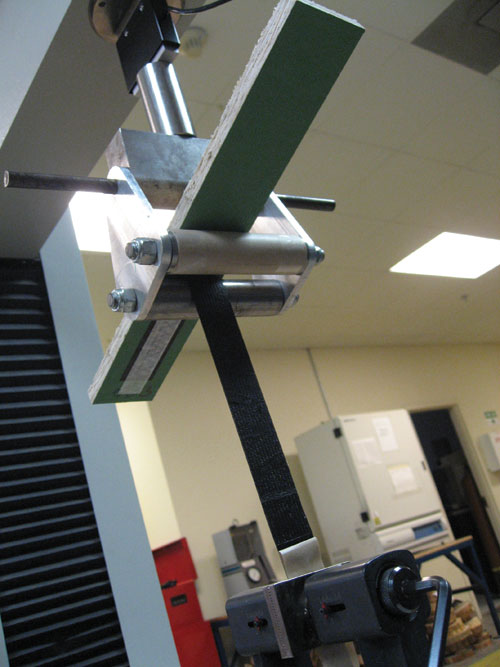 |
90-degree peel test. Photo courtesy of Huber Engineered Woods |
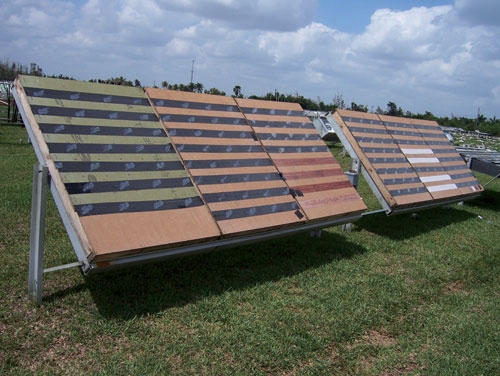 |
Long-term outdoor exposure monitoring. Photo courtesy of Huber Engineered Woods |
Above and Beyond
In addition, some manufacturers have developed their own testing mechanisms to evaluate acrylic tapes. For example:
Water ponding test. To demonstrate the ability of the acrylic tape and high-performance panels to hold out moisture, the water ponding test was developed to simulate extreme exposure to water. High-performance panels and tape were subjected to a constant head of water for over 20 hours. Both seams and fastener penetrations were monitored for water leakage. Even with this extreme exposure, a tight seal was maintained to achieve moisture resistance.
Rail car. A rail car full of flashing tape was monitored as it traveled through the Arizona desert in mid-summer to assure optimum performance of tape even after being exposed to the most extreme of shipping conditions.
“Black box.” A black metal box filled with tape was placed in an asphalt parking lot and left exposed to the extreme heat of a southern summer, providing further proof the tape can handle extreme shipping and handling conditions
Test hut walls. Cladding was removed from walls (including stucco) after five years of service and the tape examined for any deterioration. The tape showed no negative effects from its entire five years of use.
Accelerated aging. In addition to pertinent code required testing, some manufacturers have conducted tests in which tape has also been exposed to 336 hours in a UV testing chamber (equivalent to 180 days exposure in Miami, Florida) followed by 190 days in an oven at 225°F (equivalent to 30 years exposure as underlayment in Miami).
Long-term outdoor exposure. Tape has been monitored during long-term exposure and durability testing in extreme environmentssuch as Miami, Minneapolis, Australia, and Canada.
| Acrylic Tape Makes It To HGTV Dream Home 2013 | ||
Building codes don’t get much more stringent than on Kiawah Island, which sits on a flood plain, hurricane alley, and earthquake zone, and is located just south of Charleston, South Carolina. “Our seismic rating is the same as California,” says Chris Rose, AIA, HGTV Dream Home 2013 lead architect. “And the entire building was required to sit at least 8 feet above ground level because of potential flooding.” HGTV Dream Home 2013 offers a lesson in state-of-the-art construction technology. The house is air- and water-tight, thanks to its unusual sheathing, which consists of wood panels that are manufactured with a water-resistive overlay. The crew installed the panels as they would plywood, and sealed the joints with the manufacturer’s acrylic tape to prevent drafts or potential moisture intrusion. The house’s ventilation system will constantly exchange stale indoor air for fresh outdoor air, thereby eliminating any chance of indoor air pollution. This home achieved LEED Platinum certification, and the taped joints significantly added to the stringent ACH requirement.
|
Air Barriers and the Role of Self-Adhered Materials
Experts state that while heating and cooling account for 50 percent to 70 percent of the total energy used in the average home, air leaks can account for nearly half of those costs. Since heating and cooling accounts for the majority of utility costs in a typical home, stopping energy loss from air leakage offers the best opportunity for saving money and conserving resources. According to the U. S. Department of Energy, the recommended strategy in both new and old homes is to reduce air leakage as much as possible and to provide controlled ventilation as needed.
Air leakage is defined as the uncontrollable flow of air in and out of a building. It diminishes the insulating properties of a structure, and requires more energy to heat and cool a leaky building. There are two types of air leakage. Infiltration is the uncontrollable flow of outside air to the interior of the building. Exfiltration is the uncontrollable flow of inside air to the exterior of the building. In buildings, infiltration and exfiltration of air can have important implications, largely due to the unpredictable and unregulated nature of the air exchange and the possibility of admitting pollutants, allergens, and bacteria into buildings. In addition, the associated air pressure changes can impact the pressure equilibrium created by HVAC systems and work to move pollutants from certain places, say storage areas or garages, to the living space.
Exfiltration can cause moisture during the winter months when trying to heat a structure; this is seen predominantly in the northern climates. Infiltration can cause moisture during the warmer months as the hot, humid air is trying to get into the structure; this happens predominantly in the southern climates. As compared with diffusion, a type of passive transport in which molecules move from a higher to a lower concentration, the differentials in air pressure may act to move significantly more water vapor through building envelope leaks. Some experts say that hundreds of times more water vapor is moved by air pressure differentials than diffusion.1
The types of air pressure that cause infiltration and exfiltration include wind, stack pressure, and HVAC fan pressure.
Wind. Wind pressurizes a building positively on windward side, and accelerates as it goes around the building, creating negative pressure on the sides, especially the corners. Negative pressure is created on the leeward side as wind moves past the building.
Stack pressure. Also called “buoyancy” or “chimney effect,” stack pressure is the movement of air in and out of a building caused by differences in exterior and interior air pressures resulting from temperature and moisture differences. The severity of stack pressure is dependent on height of the building and thermal difference.
HVAC fan pressure. Caused by HVAC system pressurization, fan pressure is usually positive and acceptable in warm climates, though in colder environments can cause envelope problems.
Air tightening is necessary to control air infiltration and exfiltration and is achieved most efficiently through the use of an air barrier system. As a combination of materials, flexible sealed joints and building envelope elements that create air-tight, effective air barrier systems have several things in common: They are continuous, durable, strong, impermeable, and stiff. Increasingly, air barrier systems are being required by code. There are several important reasons for this. Thermal performance is improved, and utility bills are lowered. Owners have better control of indoor conditions and better indoor air quality. Perhaps most importantly, moisture is prevented from entering the wall cavity as water vapor.
Air Barrier Systems—Keeping Up to Code
Energy codes are changing faster than ever so understanding code requirements is critical when building. Various codes have different requirements, but the intent to include an air barrier system is clear. To attain an ENERGY STAR certification on a new home, builders must prove that complete air barrier systems are in place throughout the house. ENERGY STAR requires that all openings in the building envelope be sealed, including joints, seams, and penetrations; openings between window and door assemblies and framing; walls and ceilings separating a garage from conditioned spaces; common walls between units; and attic access openings.
In addition, the current International Residential Codes (IRC) includes the International Energy Conservation Code requirement of an air barrier to prevent air leakage through the building envelope (IECC Section 402.4). Compared to 2009 when seven air changes per hour (ACH) were acceptable in any climate, in 2012, this number must be decreased to 3 or 5 air changes per hour, depending on the climate zone. Generally speaking, the lower the ACH, the lower the energy bill. A “blower door test,” which measures ACH, will also become mandatory to verify code compliance. A blower door is a diagnostic tool designed to measure the air tightness of buildings, and to help locate air leakage sites. Blower door testing is typically done as part of a whole home energy audit, and can usually be modeled to help determine how much energy is needed for heating or cooling purposes.
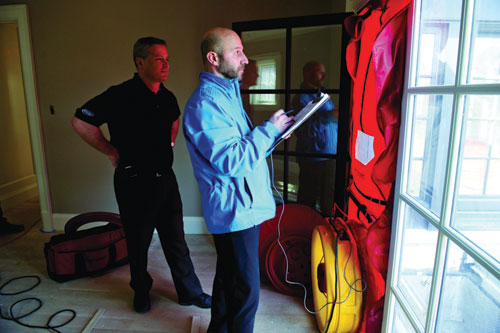 |
A blower door test measuring air changes per hour may soon become mandatory. Photo courtesy of Huber Engineered Woods |
Air Barrier Materials vs. Those That Do Not Qualify
With air barrier references appearing more frequently in codes and energy rating systems, it is important to know what goes into the creation of an effective air barrier system. According to the Whole Building Design Guide, a program of the National Institute of Building Sciences, builders and architects should carefully consider materials that will form part of such a system.
Loose-laid air barriers like housewraps can only protect against infiltration and that is only with special detailing. In order to function as an air barrier, wraps must be sealed to the wall at the bottom of a wall. The tighter you make wraps, the higher the risk of water getting trapped between the wrap and the wood sheathing, which can cause moisture-related problems with your wall system. According to experts in the field,2 materials that do not qualify as air barrier materials without additional coatings are:
- Uncoated concrete block
- Plain and asphalt impregnated fiberboard
- Expanded polystyrene
- Batt and semi-rigid fibrous insulation
- Perforated house-wraps
- Asphalt impregnated felt, 15 or 30 lb.
- Tongue and groove planks
- Vermiculite insulation
- Cellulose spray-on insulation
In adopting the simplest method of air tightening a wall, the Whole Building Design Guide recommends selecting “one of the layers such as the sheathing and to air tighten it using durable tapes, adhesive sheet products, fluid-applied materials, or the like.” However, when it comes to liquid-applied barriers, either spray on or roll-on, there are several disadvantages. The labor-intensive application process can be expensive. Cure times differ depending on the product and conditions in the immediate environment, with restrictions during certain wind and temperature conditions. In urban areas and occupied buildings, overspray can pose a significant issue. In comparison, taped wall sheathing is not as weather dependent and is much easier to install and inspect.
ACRYLIC TAPES HELP ACHIEVE AIRTIGHT BARRIERS |
Self adhesive tapes have made significant contributions in providing a rigid and continuous air barrier assembly to significantly reduce air leakage, contributing to comfort and energy efficiency. Through simple installation of panels and tape, seams and penetrations can be sealed, cutting off leak paths that compromise performance and energy efficiency. Such a high-performance assembly is code recognized as an air barrier assembly and has demonstrated performance benefits over housewrap systems. ASTM E2357 – Standard Test Method for Determining Air Leakage of Air Barrier Assemblies The ASTM E2357 Standard was developed to provide a uniform method to evaluate a full air barrier assembly. Until this method was developed, one could only evaluate pieces of the air barrier assembly such as the air barrier material alone or the flashing material alone. This method also incorporates wind loads that will push and pull on the assembly, exposing weak areas that could leak air. In this test, a full air barrier assembly of a high-performance wall assembly secured by acrylic tape was installed as an 8-foot by 8-foot mock-up of a realistic exterior wall including penetrations for pipes, electrical outlets and a window opening. All noted penetrations were flashed with acrylic tape. The system was then subjected to positive and negative sustained wind and wind gust loading simulating real life conditions. Air leakage measurements for the wall assembly were well below (less than 1/5th) the maximum allowable level. |
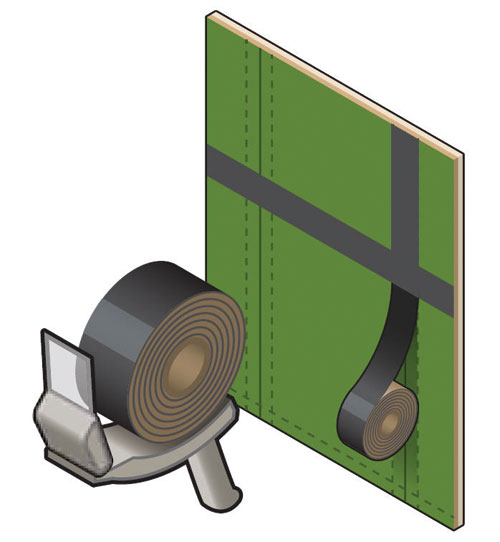 |
Acrylic tape easily fastens panel seams. Illustration courtesy of Huber Engineered Woods |
Comparison Testing - Air Movement in High-Performance Wall Assemblies and Housewrap Assemblies
In third-party air leakage testing, a wall assembly constructed with high-performance wall sheathing and acrylic tape was compared to an assembly with traditional OSB sheathing and a common housewrap with tape. Both assemblies were identically constructed for a system-to-system performance comparison. In this lab test, the high-performance wall sheathing assembly allowed significantly less air flow/leakage than the housewrap and tape system. Results indicate that a high-performance wall assembly secured with acrylic tape contributes to a tighter building envelope. These assemblies of wall panels and tape seal panel seams and allow less air leakage, resulting in greater comfort and lower energy bills for the homeowner.
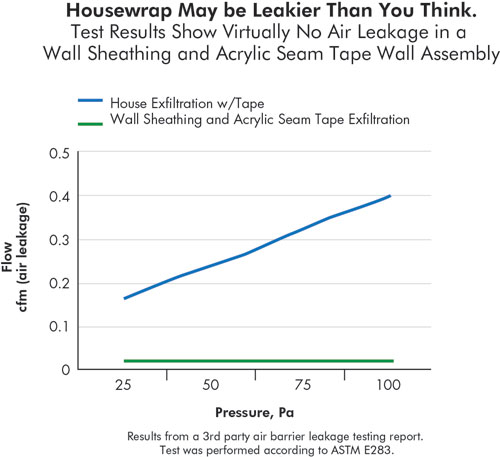 |
|
Acrylic tape outperforms housewrap in third-party testing. Illustration courtesy of Huber Engineered Woods |
How Tight is Too Tight?
The building industry is abuzz over how tight is too tight when building a home. Whether a tight envelope can have a negative impact on moisture management or air quality in the structure is being debated vigorously. Some believe that a fair amount of “accidental” air leakage is good for a home as it allows for a building to breathe. However, this accidental air is typically uncontrollable and normally of poor quality because of its origin into the building—crawlspaces, attics, garages, etc. Well-respected building science organizations such as ABAA (Air Barrier Association of America) and ASHRAE (American Society of Heating Refrigerating and Air-Conditioning Engineers) recommend that homes should be built as tightly as possible but with proper ventilation. ASHRAE, in fact, stipulates that sealing, caulking, gasketing, or weatherstripping is necessary for joints around fenestration and door frames; junctions between walls and foundations, walls and building corners, walls and structural floors or roofs, and walls and roof or wall panels; joints, seams, and penetrations of vapor retarders; and all other openings in the envelope.
Acrylic Flashing Tapes Make Sense
With air leakage a key determinant of a building's energy costs, occupant comfort, and service life, it makes good sense to design for effective airtight building envelopes. Flashing is an important consideration in maintaining air tightness. With all the types of flashing on the market, product knowledge is essential. Acrylic flashing tapes have proven in standard and manufacturer testing to have superior performance in all facets of durability as well as the ability to stand up to severe temperature and weather conditions without degradation. While a seemingly small concern in the overall construction process, the right flashing tape can add up to significant advantages for both builders and users of today's homes.
| ENDNOTES | |
| 1 | Quirouette, 1986 |
| 2 | Bombaru, Jutras and Patenaude, CMHC, 1988 |
 |
Huber Engineered Woods LLC, a wholly owned subsidiary of J.M. Huber Corporation, combines advanced resin and wood product technologies with state-of-the-art manufacturing capabilities to develop top-quality products like AdvanTech® subflooring and ZIP System® sheathing. Find out more about these innovative products by visiting Huber’s online architect library. www.huberarchitectlibrary.com |

